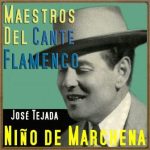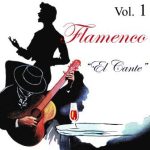NIÑO DE MARCHENA

Biography
José Tejada Marín (Marchena, Seville Province, Spain, 1903-Seville, December 4, 1976) known as Pepe Marchena, and also as Niño de Marchena in the first years of his career, was a flamenco singer who achieved great success in the ópera flamenca period (1922–1956).
Influenced by singers like Antonio Chacón, he carried to the extreme the tendency to a more mellow and ornamented style of flamenco singing. Owing to his particular vocal conditions and singing style, he excelled mainly in palos (styles) like fandangos, cantes de ida y vuelta and cantes libres, contributing to making them the most popular flamenco styles in the era of the ópera flamenca, and created a new cante de ida y vuelta, the colombiana, later recorded by many other artists like El Lebrijano or Enrique Morente. He was also the first flamenco singer to use orchestra to accompany flamenco singing, though later he returned to the guitar.
Niño de Marchena also revolutionized the public image of the flamenco singer: he was the first to sing standing on the stage (instead of sitting on a chair as it has always been usual in flamenco), and often wore unusual outfit, such as riding clothes. Both his singing style and public attitudes were widely imitated at the time, to the extent that the period has often been identified as the era of marchenismo. He was the first real popular star of flamenco singing. Until he appeared in the flamenco scene, flamenco was restricted to small venues and theatres, whereas he could attract the masses to fill large theatres and even bullrings.
Niño de Marchena started working in menial jobs as boy, alternating them with live performances in taverns for a few coins, until he won a contest for amateurs in Fuentes de Andalucía. After that, he started to work as a professional in cafés and theatres in Andalusia. In 1922, one year after his successful début in Madrid, he started singing in Teatro La Latina, with a 200 pesetas daily salary, a large sum at the time. Also in 1922, he made his first recording, and took part in the show Málaga, ciudad bravía at Teatro Martín, with guitarist Ramón Montoya. In June, he sang for the King and Queen of Italy during their visit to Spain, together with Antonio Chacón, Pastora Imperio, La Niña de los Peines and Manuel Escacena. During the twenties and thirties, he toured Spain intensively, forming part of the cast of several flamenco theatre plays like La copla andaluza (1929) and later in films (Paloma de mis amores, 1935), thus becoming the first flamenco actor-singer.
After the Spanish Civil War, he made two films: La Dolores and Martingala, and came back to the theatre in 1943 with La encontré en la serranía. In 1945 he visited Buenos Aires with the show Feria de Sevilla, together with Carmen Amaya, which stayed in the Teatro Avenida for three months, and finished his Latin American tour in Montevideo and Rio de Janeiro. In 1950 he accomplished a rare achievement for flamenco singers at the time: he started a tour in Morocco and Algeria, which was followed by concerts in Paris. During the 1950s he kept touring Spain with several concerts and theatre shows.
In 1961, he travelled to Karachi, Pakistan, to illustrate a lecture by Aziz Balouch, a Pakistani musicologist and Sufi philosophy student who had come to Spain to study flamenco and enjoyed temporary success as a flamenco singer.[4] In 1965 and 1966 he toured with show Así Canta Andalucía, taking it again to Morocco and France. Towards the end of the decade of the sixties he reduced the number of his performances. In 1974, he received an homage in his hometown of Marchena, where singers like Juan Valderrama and Perlita de Huelva took part. In 1976, already ill with cancer, he received the Gold Medal of Marchena and Juan Valderrama organized a festival in his benefit, with the participation of several artists. He died in December of that same year. In 1986, a monument in his honour was erected in Marchena.



 Maestros del Cante Flamenco: Niño de Marchena
Maestros del Cante Flamenco: Niño de Marchena Vintage Flamenco Cante
Vintage Flamenco Cante



